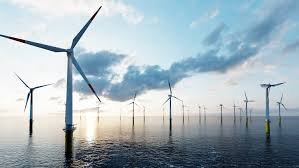
- calendar_month January 6, 2023
- folder Community
Sharing Tags
Altadena, Burbank, California, climate change, Community, Equestrian Properties, Glendale, La Canada, La Crescenta, Lake View Terrace, Pasadena, Shadow Hills, Sunland, Tujunga
Offshore wind farms are coming to the Pacific and Atlantic Ocean
Are our Oceans going to look like we just arrived in Palm Desert CA.? When driving into Palm Springs, California, from Los Angeles along Interstate-10, the first sign that you’ve arrived in the desert is the row upon row of windmills along both sides of the highway. The San Gorgonio pass can often be a wind tunnel when weather systems force air up against the San Bernardino Mountains to the north and the San Jacinto Mountains to the south. The combination of terrain and geography provides an ideal location for the placement of windmills to provide a green renewable energy source plus an attraction in and of themselves. 2700 hundred, to be exact. If all goes as planned, our Pacific and Atlantic Oceans will look the same, with even more wind turbines and up to 500 feet taller. The average wind turbine is approximately 300 feet. Offshore wind turbines will be up to 850 feet tall. Why is all of this happening?
WASHINGTON — In the pursuit of a clean energy future, the Department of the Interior announced that the Bureau of Ocean Energy Management (BOEM) will hold an offshore wind energy lease sale on Dec. 6, 2022, for areas on the Outer Continental Shelf (OCS) off central and northern California.
This will be the first-ever offshore wind lease sale on America’s west coast and the first-ever U.S. sale to support potential commercial-scale floating offshore wind energy development. This sale will be critical to achieving the Biden-Harris administration’s deployment goals of 30 gigawatts (GW) of offshore wind energy by 2030 and 15 GW of floating offshore wind energy by 2035.
Read the entire release: https://www.doi.gov/pressreleases/biden-harris-administration-announces-first-ever-offshore-wind-lease-sale-pacific
Five provisional leases were awarded in December of 2022. Three leases were awarded off Moro Bay area and the other two off the coast of Eureka California. Read the entire article: https://www.boem.gov/renewable-energy/state-activities/california
It’s sunrise, 15 miles off the coast of Atlantic City, with nothing but glassy water in every direction. A pod of Atlantic white-sided dolphins parades past, playfully breaking the summer calm. Tiny storm petrels and the occasional northern gannet swoop into view. To the east, the sun inches above the orange horizon.
In the next few years, this placid stretch of water will become a construction site. By 2024, Ocean Wind, comprising 99 sleek wind turbines, will rise more than 50 stories above the ocean’s surface—all in service of New Jersey’s thirst for energy.
America’s Largest Offshore Wind Farm is Set to Rise in Jersey. In the open ocean off Atlantic City, a developer is soon to erect 99 turbines to power 500,000 Jersey homes.
Read the complete article: https://njmonthly.com/articles/jersey-living/ocean-wind/
Can wind turbines leak oil? Taking a step back, wind turbines seem simple in design: their propeller captures wind which spins a generator to produce electricity. However, in reality, there are many more calibration procedures and components to optimize energy capture in hostile conditions. The key ingredient is oil, and turbines can have as much as 1,400 liters (369 gallons) of this inside them [ref]. Oils serve three main purposes lubrication, hydraulics, and as gear oil which are all essential when dealing with large torques and moving components. According to Patricia Pitsel, Ph.D. this oil must be replaced once a year.
The problem is that over time after constant stress, wind turbines are bound to experience damage such as cracking, pitting, and seal breakages leading to oil leaks. Despite this, servicing is infrequent as it requires scaling to the top of the turbine, so leaks may be missed. Oil leaks of any kind need immediate attention as they can mean critical parts are broken. Ultimately this can lead to environmental pollution as well as turbine collapses which only put a bad name on this clean source of energy. Accurate remote detection of these oil leaks is needed to ensure faults are fixed as soon as possible. Source - https://www.laiier.io/use-cases/wind-turbine-oil-leaks
What are the effects of oil leaks in the ocean? Apparently, some oil spills in the ocean are ok, as long as it’s from green energy and not a big oil company! This is an excerpt from an Earthsky interview. A caller asked, “What would happen if an offshore wind turbine were damaged in a storm, like the oil rig in the Gulf? Would it leak anything into the ocean?” For the answer, we asked offshore wind expert Willett Kempton, director of the Center for Carbon-Free Power Integration at the University of Delaware.
Willett Kempton There’s some oil in the gearbox of the wind turbine. So it’s a similar substance to what’s leaking off the Gulf. (Noted earlier, 389 gallons per turbine)
He’s referring to oil leaking from the Deepwater Horizon spill of April 2010. But Kempton emphasized that there’s a huge difference in the amount of oil that would leak from a toppled wind turbine. Read the entire article: https://earthsky.org/human-world/would-a-damaged-offshore-wind-turbine-leak-into-the-ocean/
How will the installation of these turbines affect fishermen? The wind farms are expected to create thousands of new jobs, but the price tag looks steep to Dameron, who fears those jobs and climate benefits will come at the expense of his industry. If wind lease areas are fully developed across the mid-Atlantic, Dameron said clam fishermen will lose access to highly productive areas of the ocean, which could send the multimillion-dollar industry into a “downward spiral”. “I could see the clam industry in Atlantic City disappearing,” Dameron said.
Dameron’s fears are being echoed by fishermen across the country as they face the arrival of a big new energy business in waters many have fished for generations.
Offshore wind, which has long struggled to take off in the US due to high costs, regulatory uncertainty, and fierce resistance from shoreside residents, is now surging forward under the Biden administration. In March, Joe Biden committed to building 30 gigawatts of offshore wind capacity by 2030, enough to power 10m homes and avoid 78m metric tons of carbon dioxide emissions. Read the entire article: https://www.theguardian.com/environment/2021/jul/24/offshore-wind-development-new-jersey-us-fishermen-ocean-life
Per the Offshore wind market report August 2022. The industry continues its trend toward larger turbines to reduce per-megawatt project costs. The average offshore wind turbine capacity installed in 2021 was 7.4 MW, slightly down from 7.6 MW in 2020, but still significantly higher than 3.3 MW in 2011. All three major European manufacturers of offshore wind turbines are working on developing 15-MW-class wind turbines with rotor diameters spanning up to 236 meters (774 feet) (compared to 158-meter-average rotor diameters, 518 feet in 2021), with plans for commercial production between 2022 and 2024. Some turbines can be up to 885 feet tall.
How far off the coast are offshore wind turbines?
Sea depth is often the limiting factor when it comes to constructing offshore wind farms. Conventional turbines rest on the seabed and can't be installed in water deeper than about 40 meters. In most regions this means they cannot be built more than 30km (18.6 miles) from shore.
Source: https://www.sciencefocus.com/planet-earth/how-far-offshore-can-we-build-wind-farms/
How long does it take to build a wind turbine in the ocean, and what is the process? While the construction of an onshore wind farm can take between 4 and 8 years, taking into account all phases of the process, the construction of an offshore wind farm is estimated to take between 7 and 11 years. Three to five years are dedicated to the development phase, one to three to the pre-construction phase, and two to four years to construct. Source https://www.iberdrola.com/about-us/our-activity/offshore-wind-energy/offshore-wind-park-construction#:~:text=While%20the%20construction%20of%20an,between%207%20and%2011%20years.
Who is the largest manufacturer of wind turbines? Here is a list of the top 15 manufacturers worldwide. Denmark grabs the number one spot. 10 of the 15 manufacturers are in China. None are located in the US.The list: https://www.blackridgeresearch.com/blog/top-wind-turbine-manufacturers-makers-companies-suppliers#:~:text=Vestas%20Wind%20Systems%20A%2FS%20(Vestas)%20retains%20the%20top,North%20America%20and%20other%20countries.
According to a report from the National Renewable Energy Laboratory (Table 30), depending on make and model, wind turbines are predominantly made of steel (66-79% of total turbine mass); fiberglass, resin, or plastic (11-16%); iron or cast iron (5-17%); copper (1%); and aluminum (0-2%).
Who are the Top 10 Steel Producing Countries In The World? Number 1: China, 2: India, 3: Japan, 4: United States, 5: Russia, 6: South Korea, 7: Turkey, 8: Germany, 9: Brazil, 10: Iran
Source: https://www.worldatlas.com/articles/the-top-10-steel-producing-countries-in-the-world.html
The US gets most of its steel from Canada, even though they rank number 4 in the world as a top steel producer.
What is the US offshore wind energy goal by 2030?
The President set a bold goal of deploying 30 gigawatts (GW), (3750 offshore turbines) by 2030, enough to power 10 million homes with clean energy, support 77,000 jobs, and spur private investment up and down the supply chain.
3750 turbines, 389 gallons of oil per turbine per year, 1,383,750 gallons per year to run the turbines. No calculation has been done to count the amount of oil used to build, service, and maintain sub-stations, cables, or damage these projects. Remember, the average project time is 10 to 11 years from the start of planning to completion.
Who has a fully operational offshore wind farm? A facility described by Danish energy firm Orsted as the “world’s biggest offshore wind farm” is now fully operational, with its 165 turbines set to help power in excess of 1.4 million U.K. homes.
Situated roughly 89 kilometers (approximately 55 miles) off the coast of Yorkshire, England, the scale of Hornsea 2 is considerable.
According to Orsted, it has a capacity of more than 1.3 gigawatts and stretches across an area of 462 square kilometers — more than half the size of New York City.
Complete article: https://www.cnbc.com/2022/09/01/huge-offshore-wind-farm-hornsea-2-is-fully-operational-orsted-says.html
Take a look at the images Hornsea 2 wind project: https://www.evwind.es/2022/08/31/hornsea-2-the-worlds-largest-wind-farm-enters-full-operation/87630
What will our coastal views from shore and or the ocean become? If the US relies too heavily on other countries to build and supply this move to wind, do we also rely too heavily on other countries having control over our power supply? Is this really a green move for the US?
